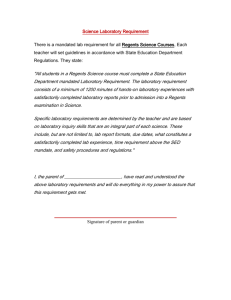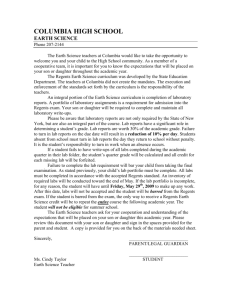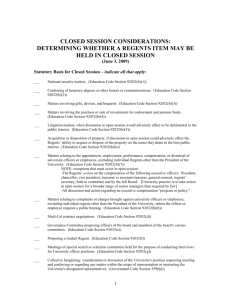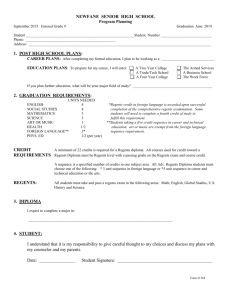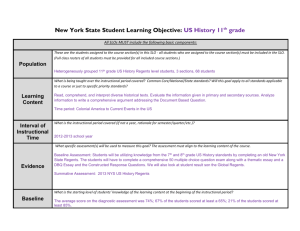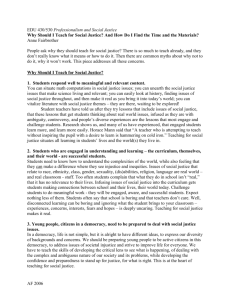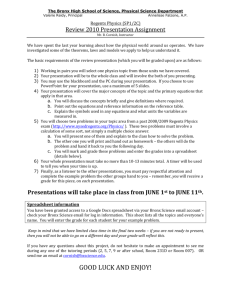AP Physics C – Mechanics
advertisement
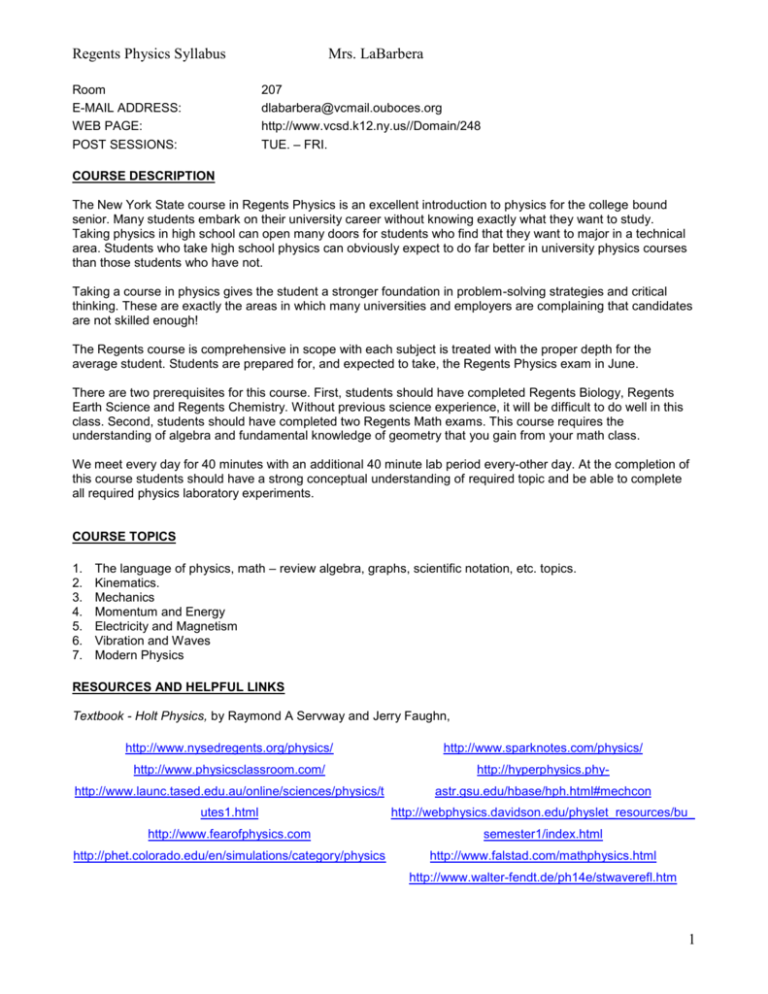
Regents Physics Syllabus Room E-MAIL ADDRESS: WEB PAGE: POST SESSIONS: Mrs. LaBarbera 207 dlabarbera@vcmail.ouboces.org http://www.vcsd.k12.ny.us//Domain/248 TUE. – FRI. COURSE DESCRIPTION The New York State course in Regents Physics is an excellent introduction to physics for the college bound senior. Many students embark on their university career without knowing exactly what they want to study. Taking physics in high school can open many doors for students who find that they want to major in a technical area. Students who take high school physics can obviously expect to do far better in university physics courses than those students who have not. Taking a course in physics gives the student a stronger foundation in problem-solving strategies and critical thinking. These are exactly the areas in which many universities and employers are complaining that candidates are not skilled enough! The Regents course is comprehensive in scope with each subject is treated with the proper depth for the average student. Students are prepared for, and expected to take, the Regents Physics exam in June. There are two prerequisites for this course. First, students should have completed Regents Biology, Regents Earth Science and Regents Chemistry. Without previous science experience, it will be difficult to do well in this class. Second, students should have completed two Regents Math exams. This course requires the understanding of algebra and fundamental knowledge of geometry that you gain from your math class. We meet every day for 40 minutes with an additional 40 minute lab period every-other day. At the completion of this course students should have a strong conceptual understanding of required topic and be able to complete all required physics laboratory experiments. COURSE TOPICS 1. 2. 3. 4. 5. 6. 7. The language of physics, math – review algebra, graphs, scientific notation, etc. topics. Kinematics. Mechanics Momentum and Energy Electricity and Magnetism Vibration and Waves Modern Physics RESOURCES AND HELPFUL LINKS Textbook - Holt Physics, by Raymond A Servway and Jerry Faughn, http://www.nysedregents.org/physics/ http://www.sparknotes.com/physics/ http://www.physicsclassroom.com/ http://hyperphysics.phy- http://www.launc.tased.edu.au/online/sciences/physics/t astr.gsu.edu/hbase/hph.html#mechcon utes1.html http://webphysics.davidson.edu/physlet_resources/bu_ http://www.fearofphysics.com semester1/index.html http://phet.colorado.edu/en/simulations/category/physics http://www.falstad.com/mathphysics.html http://www.walter-fendt.de/ph14e/stwaverefl.htm 1 Regents Physics Syllabus Mrs. LaBarbera GRADING SYSTEM Category 1st Quarter 2nd Quarter 3rd Quarter 4th Quarter Tests & Exams Lab 60% 5% 40% 5% 60% 5% 60% 5% Project/formal lab 5% 5% 5% 5% Class work/ Participation 10% 10% 10% 10% Homework 10% 10% 10% 10% Quizzes 10% 10% 10% 10% Midterm Exam 20% Course Grade Students will receive a course grade that is an average of their grade for each of the four quarters and their score on the Regents Exam. Thus, each quarter and the Regents Exam will comprise 20% of the final course grade. Midterm The physics department administers a district-wide midterm exam during "Midterm Week" in January. This exam includes Regents level questions and will count for 20% of the student's second quarter grade. Tests and Exams A test is a 25 point assessment with a blend of multiple choice and extended response questions. Tests are typically given in the middle of a large unit of instruction. An exam is given at the end of each unit and is a two part assessment. Part One of the assessment will consist of 25 multiple choice questions. Part Two of the assessment will consist of 25 points worth of extended response questions. The two parts of the exam carry equal weight to each other and to all other tests and exam parts given in the same quarter. All tests are built using questions from past Regents exams and/or questions based directly on Regents exam questions. Lab All labs will be documented in a personal lab-notebook which will be kept in the classroom. Students will be required to complete at least 1200 minutes of lab (about 30 labs) time with a complete lab report in order to pass the course. Project/Formal Lab One Project per quarter will be designated as a "formal lab". This project will be subjected to strict grading criteria and will be important in teaching students how to produce high quality lab reports. Class work / Participation Class work includes any formal or informal assessment of student work or preparedness for class. Most of the class work grades will consist of "Do Now's", "Exit Slips", and "Activities". Participation includes attendance, attentiveness to tasks during class and ability to work well with others. Participation grade heavily rewards effort on the part of the student. Homework Homework is assigned from your textbook or from the http://www.castlelearning.com website. Homework is assigned everyday; it will take an average student about half an hour to complete. Homework will be collected and graded daily. According to research, completion of homework in high school produces a gain of about 24 percentile points. Quizzes Quizzes will be given in the weeks in which no test is scheduled. They generally consist of five to fifteen questions that directly reflect the questions assigned on previous homework. 2 Regents Physics Syllabus Mrs. LaBarbera REQUIRED SUPPLIES Lab notebook Binder (suggested) Protractor with ruler calculator CLASSROOM RULES OF CONDUCT 1. No electronic devices are allowed during school. 2. Come to class on time. Standing outside the door and rushing in after the bell has begun to ring will constitute a tardy. You must be INSIDE the door when it begins ringing to be counted on time. If you are on time for five weeks, you will get one homework pass. 3. Begin do now activity within one minute after the second bell. Do now is part of participation grade. 4. Attend to personal needs before coming to class. I have been instructed not to give passes to lockers and to limit passes, so please do not ask for a pass unless you have a true emergency. If you used less than two passes for five weeks, you will get one homework pass. 5. Remain in your assigned seat unless you have permission to get up. Throw scraps away at the end of the period on your way out. 6. Bring required materials every day. If you bring all you supplies for a quarter, you can get a quiz pass for the quarter. 7. Talk only when permitted. Be aware of the situation since quiet talking is allowed in some situations and speaking to the entire group without raising your hand may be allowed in others. I will remind you once and expect compliance. 8. Use polite speech and body language. Unkind teasing and impolite behavior is unacceptable. 9. Do not cheat. Students caught cheating will receive a zero and a phone call home. Both the student who shares his work for an independent assignment AND the person who copies it will suffer the same consequences. I expect you to do your own work and to be sure no one can copy it. 10. Sign in when you are late or when you are back from a leave; Sign out when you leave the class. 3 Regents Physics Syllabus Mrs. LaBarbera TENTATIVE SCHEDULE Unit Overview of Topics Math Prep A review of the various mathematical tools students will need during the year. Students will get review in: algebra; trigonometry; significant figures; scientific notation; graphing; and unit conversions. There will be no tests in this unit, however students will take a series of quizzes in the various topics presented. Motion of objects in one-dimension is described using words, diagrams, numbers, graphs, and equations. Motion in one dimension Text Chapters # of Weeks 1 Quiz 9/11 2 2 Test 9/25 2-D motion and vectors Vector principles and operations are introduced and combined with kinematics principles and Newton's laws to describe, explain and analyze the motion of objects in two dimensions. Applications include riverboat problems, projectiles, inclined planes, and static equilibrium. 3 3 Unit Exam 10/16 Forces and laws of motion Newton's three laws of motion are explained and everyday forces are analyzed. 4 Rotational Motion and Law of Gravity Newton's laws of motion and kinematics principles are applied to describe and explain the motion of objects moving in circles; specific applications are made to roller coasters and athletics. Newton's Universal Law of Gravitation is then presented and utilized to explain the circular motion of planets and satellites. The impulse-momentum change theorem and the law of conservation of momentum are introduced, explained and applied to the analysis of collisions of objects. 7 3.5 Test 11/9 1 Unit Exam 11/20 6 2 Test 12/21 Work and Energy Concepts of work, kinetic energy and potential energy are discussed; these concepts are combined with the work-energy theorem to provide a convenient means of analyzing an object or system of objects moving between an initial and final state. 5 3 Unit Exam 1/15 Mid term review and test Review the previous 7 topics 2-7 0.5 Momentum and Collisions 4 Regents Physics Syllabus Electric forces and fields Current and resistance Electric circuits and Magnetism Mechanical waves /Sound waves Electromagnetic waves Light waves, Reflection and refraction of light Modern physics Final review Mrs. LaBarbera Basic principles of electrostatics are introduced in order to explain how objects become charged and to describe the effect of those charges on other objects in the neighboring surroundings. Charging methods, electric field lines and the importance of lightning rods on homes are among the topics discussed in this unit. The flow of charge through electric circuits is discussed in detail. The variables which cause and hinder the rate of charge flow are explained. The mathematical application of electrical principles to series, parallel and combination circuits is presented. Magnets and magnetic fields are discussed. The nature, properties and behaviors of waves are discussed and illustrated; the unique nature of a standing wave is introduced and explained. The nature of sound as a longitudinal, mechanical pressure wave is explained and the properties of sound are discussed. Wave principles of resonance and standing waves are applied in an effort to analyze the physics of musical instruments. The behavior of light waves is introduced and discussed; polarization, diffraction and interference are introduced as supporting evidence of the wave nature of light. The ray nature of light is used to explain how light reflects off of a plain mirror to produce virtual images; how light refracts at planar surfaces; Snell's law and refraction principles are used to explain a variety of real-world phenomena; E = h∙λ is used to explain the duality of energy and matter. Model of atoms is introduced and is used to explain the atomic spectra. Mass-energy relationship is presented and standard model of particle physics is described. Review of all topics 17, 18 2.5 Test 2/12 19, 20, 21 4.5 Unit Exam 3/22 12, 13 2.5 Test 4/19 14, 15,16 2 Unit Exam 5/3 23 1.5 Unit Exam 5/17 1-7; 1221, 23 3 Regents Exam 5 Regents Physics Syllabus Mrs. LaBarbera Probable Labs We will complete at least 20 of the following labs. Each lab will conclude with a lab report that includes a Title, a Purpose, a Data section, and a Conclusion. The reports are kept in a notebook in the classroom. New York State board of education may ask to see this portfolio, so it is important that you work hard on your labs. chapter Lab Title Brief Description The circle lab Determine the relationship between diameter and circumference of a circle. Estimation lab Determine the thickness and the mass of a loose-leaf paper – Explore the use of prefixes. Discovery lab Motion Observe objects moving at a constant speed and objects moving with changing speed. Graph the relationships between distance and time for moving objects. Interpret graphs relating distance and time for moving objects. Graph Matching Predict, Sketch and test velocity-time graphs of a described motion. Project 1: Race car construction Construct a model car to meet assigned criteria. Use concepts in physics to measure the performance of the car. Quick Lab: Time interval of freefall Determine your reaction time using kinematics equations Measuring time and motion Measuring motion in terms of the change in distance during a period of the timer or motion detector. Free fall (picket fence) Determine the acceleration of gravity using photo gates, picket fences and the logger pro program. Discovery lab Vector Treasure Hunt Create a series of directions that lead to a specific object. Follow directions to locate a specific object. Develop a standard notation for writing direction symbols. Generate a scale map. Quick Lab: Projectile motion Determine all projectiles has the same vertical acceleration Math Prep Motion in one dimension 2-D motion and vectors Velocity of a projectile Projectile Projectile simulation lab Measure the velocity of projectiles in terms of the horizontal displacement during free fall. Compare the velocity and acceleration of projectiles accelerated down different inclined plane. Develop a model that can be used to simulate a car driving off a cliff on a movie set. Analyze the relationship between the horizontal velocity and impact point of a projectile, using this model. Evaluate the assumptions made by the model. • Predict the velocity required for the car to land at the targeted spot on the beach. Determine the initial speed and the angle of the projectile so that it will hit the target using the PHeT simulation. 6 Regents Physics Syllabus Discovering Newton’s Laws Quick Lab: Forced and change in motion Quick Lab: Inertia Force and Acceleration Forces and laws of motion Invention Lab: Testing Material Static and Kinetic Friction Air Resistance Discovery Lab: Circular motion Circular Motion and The Law of Gravity Explore the factors that cause a change in motion of an object. Identify the forces that caused change in motion Determine the relationship between mass and inertia Determine the relationship between force, mass and acceleration using force sensors, logger pro program Determine the coefficients of static and kinetic friction for a variety of surfaces. Classify materials according to coefficients of friction. Compare the coefficients of static friction to the coefficients of kinetic friction. Develop a method for determining coefficients of static and kinetic friction for shoes on roofing material. Measure forces of static and kinetic friction using a force sensor. Determine if forces of friction or coefficients of friction depend on weight. Recommend shoes that are suitable for people working on roofs. Develop a physical model that simulates an object falling with a parachute. Analyze the relationship between mass and terminal speed of a falling object using data from the model. Evaluate two mathematical models relating air resistance to terminal speed using data generated in the simulation. Calculate an air resistance factor for the model. Predict the required air resistance factor for the parachute and the maximum allowable load for the drop. Distinguish between forces required to hold a variety of masses in a horizontal circular path moving at several speeds. Compare the circular motion of masses to the linear motion of masses. Discover the relationship between mass, speed, and the force that maintains circular motion. Quick Lab: Radian and Arc length Verify Circumference = 2π (radian) Centripetal Acceleration Develop a model to measure acceleration using a turntable. Determine the relationship between centripetal acceleration, radius, and angular velocity using the model. Calculate the radius and angular velocity to be used in new amusement park rides based on your data. Circular Motion Phet-gravity force lab Project 2: Egg Drop Momentum and Collision Mrs. LaBarbera Conservation of Momentum Quick Lab: Elastic and Inelastic collisions Examine the relationship between the force that maintains circular motion, the radius, and the tangential speed of a whirling object. To determine the effect of separation distance, object mass and planet mass upon the gravitational force of attraction between an object and a planet. Construct a contraption to satisfy assigned criteria Measure the mass and velocity of two carts. Calculate momentum of each cart. Verify the law of conservation of momentum. To compare kinetic energy before and after collision for a brand new tennis ball and an old tennis ball. 7 Regents Physics Syllabus Loss of Mechanical Energy Work, Energy, Power Exploring Work and Energy Measure the change in the kinetic and potential energy as a ball moves up and down in free fall. Graph potential energy, kinetic energy, and total energy. Analyze the graph to determine how much kinetic energy is lost. Reach conclusions regarding the amount of energy possessed by the volleyball as it fell in the neighbor’s driveway. Measure the force required to move a mass over a certain distance using different methods. Compare the force required to move different masses over different time intervals. Quick Lab: Mechanical energy To conclude that energy can be transferred, but energy is conserved. Conservation of mechanical energy Determine spring constant of a spring. Calculate elastic potential energy. Calculate gravitational potential energy. Determine whether mechanical energy is conserved in an oscillating spring. Discovery lab: Charges and Electrostatics Stations lab Static Electricity Mrs. LaBarbera Project 3: Levitating Toys Electric Field Simulation Coulomb's Law Lab Electric Field Lines Lab Discovery lab: Resistors and Current Investigating Resistance Discovery Lab: Exploring Circuit Elements Current Electricity Quick Lab: Simple Circuits Quick Lab: Series and Parallel Circuits Resistors in Series and in parallel Discover the electrical properties of metallic and nonmetallic objects. Construct an electroscope and investigate how it works. Observe forces between charged and uncharged objects. To charge a variety of materials by rubbing them together and to examine their interactions with a positive, negative and neutral object in order to rank the materials according to their relative affinity for electrons. Use appropriate lab safety procedures. Design and implement procedure. Manipulate electrostatic field forces to cause objects to levitate. To identify the variables which do and do not affect the strength of the electric field intensity at a given location surrounding a source of charge? To use Coulomb's law and vector principles to determine the number of electrons which are transferred to a balloon as the result of 10 average-strength rubs on animal fur. To describe the nature of the electric field line pattern in the space surrounding a positive charge, a negative charge and a configuration of two or more charges. To determine the mathematical relationship (i.e., equation) relating the voltage, current and resistance in a simple circuit Determine the resistance of conductors using the definition of resistance. Explore the relationship between length, diameter, material, and the resistance of a conductor. Construct circuits using different combinations of bulbs, batteries, and wires. Observe the effects of an electric current. Compare your observations from different trials to discover how relationships are affected by changing one or more variables. Classify and analyze your observations. Explain exactly which parts of the bulb, battery, and wire must be connected for the light bulb to produce light. Construct series and parallel circuit with drinking straws Measure current in the potential difference across resistors in series and in parallel. Find unknown resistance of two resistors. Calculate equivalent resistance. Analyze the relationship between potential difference, current, and resistance in a circuit. 8 Regents Physics Syllabus Discovery Lab: Pendulum and spring waves. Determine the factors that influence the time interval required for a pendulum to complete one full swing. Investigate the nature of pendulum and wave motion. Quick Lab: Energy of a Pendulum. Observe how kinetic energy of a pendulum changes as its displacement changes. The pendulum and simple harmonic motion Speed of sound Construct simple pendulums, and find their periods. Calculate the value for g, the free fall acceleration. Example relationships between length, mass, and period for different pendulums. Test a spring to find the elongation of the spring due to applied masses. Test a rubber band to find the elongation of the band due to applied masses. Plot a force-versus-elongation curve for both the spring and for the rubber band. Find the spring constant of the spring from the slope of the spring graph. Design experiments to determine the factors that may affect the period of a pendulum. Test the relationship between length, mass, amplitude, and the period of a pendulum. • Recommend the specific characteristics of a clock pendulum using your data. Determine speed of sound in air Quick Lab: Resonance Explain pumping swing using resonance. Quick Lab: A Pipe Closed at One End Determine how the pitch produced by blowing into a straw change with the length of the straw. Develop a setup that allows you to analyze sound waves for frequency and amplitude. Analyze the waveforms of a tuning fork and a musical instrument. Model waveforms using a mathematical expression derived from your data. Observe beat frequencies when two waveforms are combined. Evaluate your ability to tune by ear based on beat frequencies in the combined waveform. Apply physics principles to the design of a musical instrument. Describe the instrument using the concepts of frequency, pitch, and resonance. Invention Lab: Tensile Strength and Hooke’s law Mechanical waves and sound Pendulum Periods Sound Waves and Beats Project 4: Building a Musical Instrument Brightness of Light Quick Lab: Polarization of Light Electromagnetic waves, reflection and refraction Modern physics Mrs. LaBarbera Find the relationship between the intensity of the light emitted by a light source and the distance from the source. Compare light intensity between different orientations of a polarizer Discovery Lab: Light and Mirrors Determine the width of a hair sample using the concepts of diffraction and interference. Form images using mirrors. Locate images using different methods. Refraction To determine the index of refraction of the unknown materials. Quick Lab: Periscope Construct a periscope with prisms using concept of total internal reflection. A Critical Angle Lab To determine the critical angle for the water-air boundary and for the Lucite-air boundary. Nuclear Fission PhET lab – How to use fission to produce nuclear energy What is inside an atom PhET lab – investigate structure of hydrogen atom Diffraction 9

